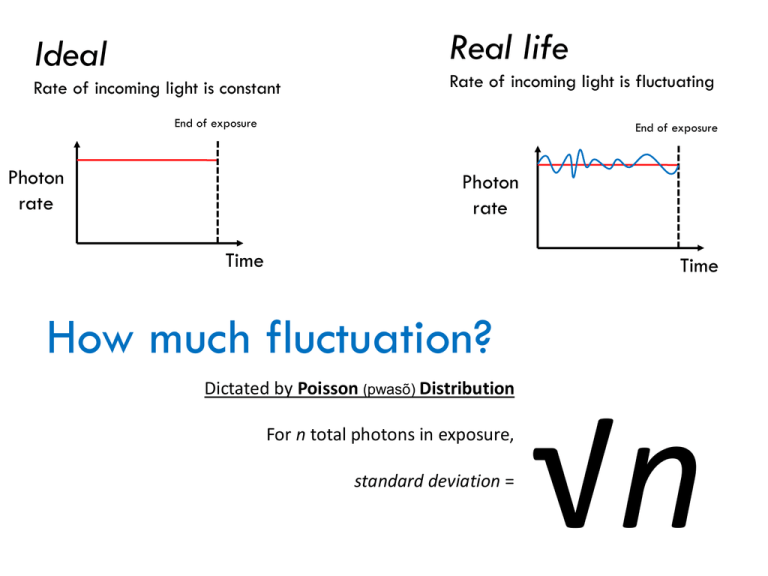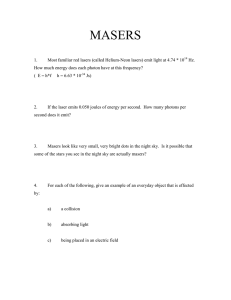Week 6 PowerPoint v2007 (2.8MB)
advertisement

Real life Ideal Rate of incoming light is constant Rate of incoming light is fluctuating End of exposure Photon rate End of exposure Photon rate Time Time How much fluctuation? Dictated by Poisson (pwasõ) Distribution For n total photons in exposure, standard deviation = √n √n, so what? Photons collected = n + √n Variable brightness = noise! If n = 10,000 photons, Photons collected = 10,000 + √10,000 = 10,000 + 100 photons 10,000 photons Noise monster One of the photographer’s worst enemies 9,900 photons 10,100 photons 9,950 photons Proportion of fluctuation 12% Proportion of Photon Fluctuation (√(n)/n) sqrt(n)/n 10% 8% 6% 4% 2% 0% 0 1000 2000 3000 4000 5000 Photons 6000 7000 8000 9000 10000 12% Canon 5D Nikon D300 Proportion of Photon Fluctuation (√(n)/n) Sony H9 10% 8% 6% 4% 2% 0% 0 10000 20000 30000 40000 Photons 50000 60000 70000 80000 90000 12% Canon 5D Nikon D300 Proportion of Photon Fluctuation (√(n)/n) Sony H9 10% 8% 6% 4% 2% 0% 90 900 9000 Photons 90000 12% Sony H9 Proportion of Photon Fluctuation (√(n)/n) Sony H9 10% 8% 6% 4% 2% 0% 0 500 1000 1500 Photons 2000 2500 3000 3500 8% Canon A570IS ISO1600 Canon A570IS Proportion of Photon Fluctuation (√(n)/n) 7% Canon A570IS 7.1 Megapixels 1/2.5” sensor 5.76 x 4.29mm (24.7mm2) Density: 3.48 μm2/pixel 6% ISO800 5% ISO400 4% 3% ISO200 ISO100 2% 1% 0% 0 500 1000 1500 Photons 2000 2500 3000 3500 ISO100 ISO200 ISO400 ISO800 ISO1600 Canon A570IS 7.1 Megapixels 1/2.5” sensor 5.74 x 4.3mm (24.7mm2) Density: 3.48 μm2/pixel 8% 1600 6% 800 4% 400 200 100 2% 0% 0 1000 2000 3000 4000 images: dcresource.com ISO100 ISO200 ISO400 ISO800 ISO1600 Fuji F30 6.1 Megapixels 1/1.7” sensor 7.7 x 5.77mm (44.4mm2) Density: 7.27 μm2/pixel 8% 6% 1600 800 4% 400 200 100 2% 0% 0 2000 4000 6000 8000 images: dcresource.com ISO100 ISO200 ISO400 ISO800 ISO1600 Canon 30D 8.2 Megapixels APS-C sensor 22.5 x 15mm (337.5mm2) Density: 41.16 μm2/pixel 8% 6% 4% 2% 1600 800 400 200 100 0% 0 20000 40000 60000 images: dcresource.com F30 6.1 Megapixels 7.7 x 5.77mm (44.4mm2) Density: 7.27 μm2/pixel F30 30D 8.2 Megapixels 22.5 x 15mm (337.5mm2) Density: 41.16 μm2/pixel 30D A570IS 7.1 Megapixels 5.76 x 4.29mm (24.7mm2) Density: 3.48 μm2/pixel A570IS 8% Canon A570IS Fuji F30 Proportion of Photon Fluctuation (√(n)/n) 7% Canon 30D Canon 5D 6% 5% 4% 3% 2% 1% 0% ISO100 ISO200 ISO400 ISO ISO800 ISO1600 Making matters worse, circuitry must occupy some space between each photowell – the more photowells, the more space circuitry takes up. Summary More pixels, smaller sensor => less light per pixel => more noise Less pixels, bigger sensor => more light per pixels => less noise In theory, the biggest sensor with the least pixels will give us the best image, in terms of noise. A 1-pixel sensor would be ideal. With 1 pixel, we’d have low noise but no detail. Many pixels => High detail, high noise Few pixels => Low detail, low noise The “Megapixel Myth”: Detail vs. Noise Megapixels: Detail vs. Noise How many pixels do we need?: Facebook profile picture: 0.03 MP If you only look at pictures on the computer, 2-3MP 4x6 studio print at 300dpi: 2.16 MP 5x7 studio print at 300dpi If you make non-poster-size prints (4x6,3.15 5x7,MP8x10), 3-4MP Standard VGA TV: 0.35 MP 1080p HDTV: 2.07 MP More pixels beyond this don’t add detail, and contribute to greater noise 1280x1024 19” LCD monitor: 1.31 MP 8.5x11in, 300dpi magazine spread: 8.42 MP 8x10 inkjetprint at 200dpi: 3.20 MP 10x14in, 150dpi full-page spread in Daily Cal: 3.15 MP Giant 20x30in poster print at 150dpi: 13.5 MP





